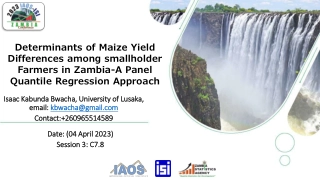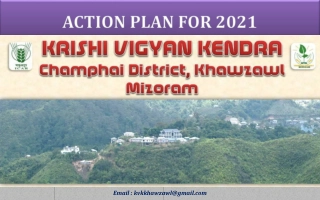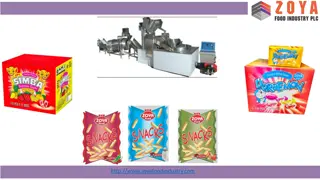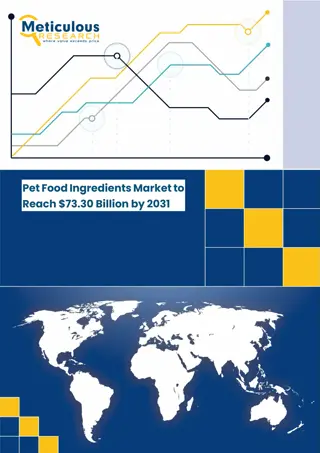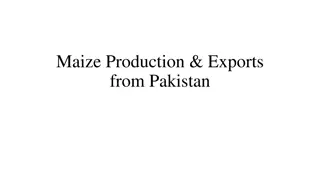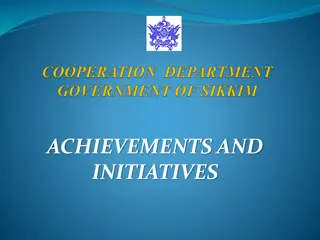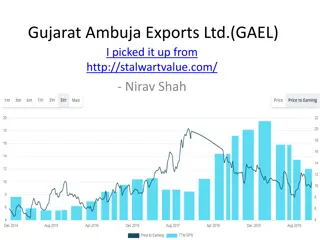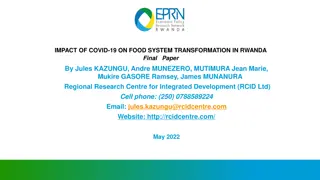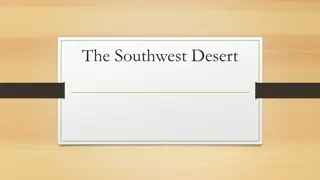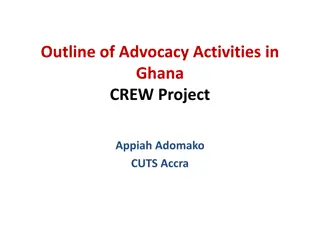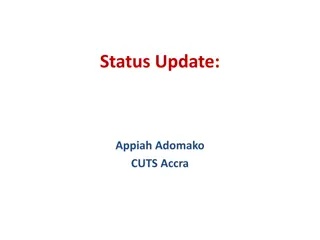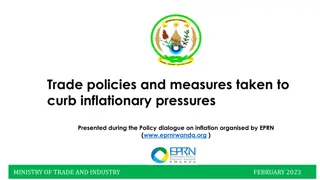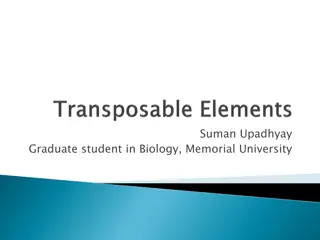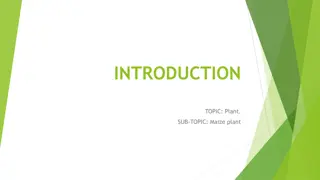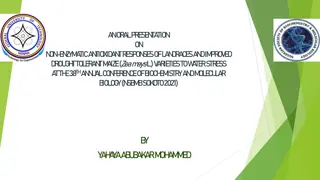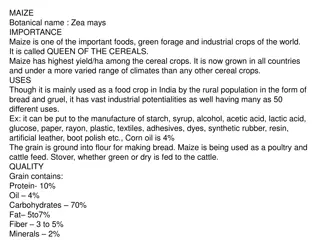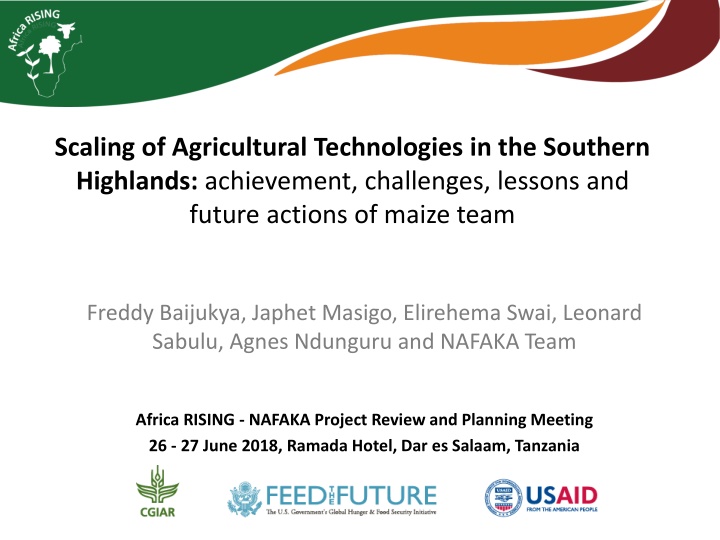
Sustainable Agricultural Innovations for Maize Production in Southern Highlands
Explore the achievements, challenges, and future plans of the maize team in scaling agricultural technologies in the Southern Highlands. Learn about their core business, implemented activities, crop productivity factors, and identified climate-smart agriculture practices.
Download Presentation

Please find below an Image/Link to download the presentation.
The content on the website is provided AS IS for your information and personal use only. It may not be sold, licensed, or shared on other websites without obtaining consent from the author. If you encounter any issues during the download, it is possible that the publisher has removed the file from their server.
You are allowed to download the files provided on this website for personal or commercial use, subject to the condition that they are used lawfully. All files are the property of their respective owners.
The content on the website is provided AS IS for your information and personal use only. It may not be sold, licensed, or shared on other websites without obtaining consent from the author.
E N D
Presentation Transcript
Scaling of Agricultural Technologies in the Southern Highlands: achievement, challenges, lessons and future actions of maize team Freddy Baijukya, Japhet Masigo, Elirehema Swai, Leonard Sabulu, Agnes Ndunguru and NAFAKA Team Africa RISING - NAFAKA Project Review and Planning Meeting 26 - 27 June 2018, Ramada Hotel, Dar es Salaam, Tanzania
Outline Core business of maize- team Implemented activities and achievement Challenges and lessons learned Future plans
1. Core business of maize team in context Maize team focuses on 3 out (out of 4) strategic partnership areas of AR-NAFAKA projects; I. Promotion of climate smart agriculture (CSA) innovations to increase resilience of people and natural resources to climate shocks and their impacts II. Reduced food waste and spoilage III. Improved household nutrition through crop diversification IV. Capacity building of extension staff and farmers to empower, create sustainability and institutionalize AR-NAFAKA approaches
2. Implemented activities and achievement 2.1 Inception meetings: to introduce the project, confirm climate related production challenge, select appropriate CSA practices and agree on how to implement the project District Villages Date of meeting Mbozi Nansama; Isansa Iwalanje 31/10/2017 Momba Namawale, Nandanga 03/11/2017 Mufindi Utosi, Igomaa 6/11/2017 Wanging ombe Mchanganyiko; Mayale Kilolo Italula, Isoliwaya 7/11/2017 8/11/2017 Iringa rural Kihorogota; Uhominyi 9/11/2017
The following factors were reported to affect crop productivity I. Inadequate and erratic rains. II. Low soil fertility III. High prices of seed of improved varieties IV. Soil acidity (in Upper Kilolo) V. Higher incidences of pests and diseases notably stalk borer (locally called luhoma ) and FAWPoor knowledge on suitable crop varieties (Maize, soybean common bean), VI. Poor agronomic practices VII. Soil erosion (Upper Kilolo
2.2 Identified CSA practices for inclusion in demonstration plots District ng ombe - Demonstrated practices Iringa DC Mufindi Momba Wangi- Mbozi Kilolo 1 Lime/SWM/ fertilizers/improved maize varieties - - 22 - - 2 Lime/SWM/ fertilizers/improved soybean varieties SWM/ fertilizers/drought tolerant maize varieties - - - 10 - - 3 - - 5 10 20 - 4 High yielding maize with appropriate N and P fertilizers rates 25 15 - - 10 5 25 15 - - - 10 High yielding common bean varieties with appropriate N and P fertilizers rates
Number of established mother and baby demonstrations districts District Maize Common bean Mother Mother* Baby** Baby Kilolo 37 185 - - Iringa rural 20 100 - - Mufindi 10 45 4 20 Wanging ombe 10 50 - - Mbozi 25 125 25 125 Momba Total 15 117 125 630 15 44 75 220 *A demonstration with 4-6 treatments managed by a group of farmers (25-50) ** A demonstration managed by an individual farmer, composed of a sub-set of treatments in the mother demonstration
2.3 Field days: are conducted in partnership with inputs supply companies (Seed Co, MOSANTO, MERU AGRO and TFA. Participants District Female Male Iringa rural 319 299 Wanging ombe 78 91 Mbozi + Momba 883 1,741 Total 1,280 2,131
2.4 Capacity building done on GAP on maize, bean and soybean Soil water management Use of lime Management of Fall Army Worm Fertilizer use (type, rate, timing and method of application Number trained by April, 2016 o 234 extension officers o 15 agrodealers o 4,669 farmers
2.5 Strengthening production and distribution of legume seeds under Community seed production program Done in collaboration with N2Africa, CRS, TOSCI and Ministry of Agriculture DISTRICT Gender Male Female Total Kilolo 05 01 06 Mufindi 08 11 19 Iringa rural Mbozi 7 6 13 14 7 21
QDS farmers are promoted to produce certified seed - Independent seed growers - become out growers for local seed companies Seed growers on training by a local seed Company Agriseed in the field (A) and in seed handling and storage at Agriseed warehouse (B)
2.6 Production of extension materials Draft extension materials produced: information need to be harmonized i. Mwongozo wa Kilimo Bora cha Mahindi-Nyanda za Juu Kusini mwa Tanzania ii. Mwongozo kuhusu kilimo bora cha zao la maharage iii. Better soybean through good agricultural practices F iv. for farmers in Tanzania. v. Better beans through good agricultural practices for farmers in southern highlands of Tanzania vi. Technology brief for Soybean production in Tanzania vii. Technology brief for common bean production in Tanzania viii. Compendium of Maize Production training protocols ix. Training manual on SWM (for farmers and extension officers)
2.7 Success stories Draft available on: i. Mkungugu QDS producer Obedi Chonya by Silvanus Mruma and Filbert Mzee ii. Sprayer service providers(SSP) by Filbert Mzee iii. Maize-legume crop rotation by Silvanus and F Baijukya iv. Richard Mlozi achieving higher maize yield through application of GAP by Ibrahim Mkwiru v. Soil and water conservation practices in Iringa rural by Elirehema Swai
3. Challenges and Solutions i) Outbreak of Fall Armyworm (Spodoptera frugiperda) and stalk borer (Busseola fusca) in all project sites, diverted attention of project staff and resources to support farmers 189 government extension staff and 1,340 farmers were trained on FAW management who in turn supported fellow farmers 8 Spray gangs were formed for fast response Appropriate pesticides mobilized and became available through agrodelears ii) Late onset of rains and prolonged drought spells in Iringa resulted to late application of top-dressing fertilizer .
iii) Acid crop land but farmers unaware Lime not available and costly No recommendations on lime application 4.7 Mha are potentially suffering the effects of acidity
iii) Poor performance of Yara Mila Cereal fertilizers in Mbozi District A task force to look into the issue was formed (composed of 2 AR-NAFAKA staff, 1 YARA staff and soil Scientist form ARI Uyole). The team carried interview with farmers and collected soil samples for further investigation. Findings expected by Mid August. s
Lessons 1. Level of infestation by FAW is high during dry spells, thus seasons with little rains and or poor rainfall distribution are likely to have considerable damage. Farmers need to get prepared. 2. FAW management requires skills not available with common farmers. Creation, and registering spray teams as service providers appears to be feasible solution to manage the pest
Acknowledgement USAID for funding and advice AR -Leadership Participating farmers
Thank You Africa Research in Sustainable Intensification for the Next Generation africa-rising.net This presentation is licensed for use under the Creative Commons Attribution 4.0 International Licence.

